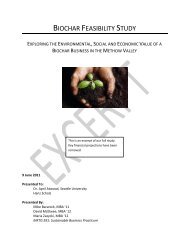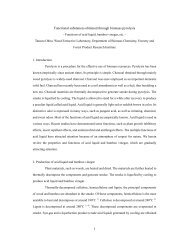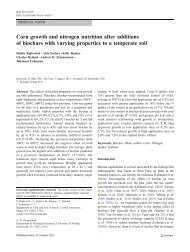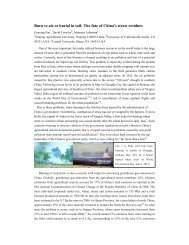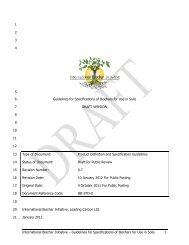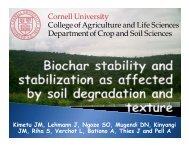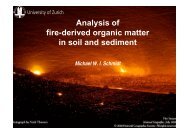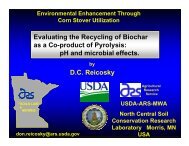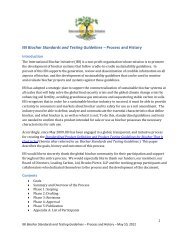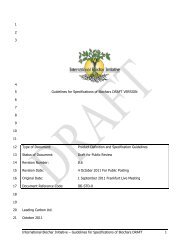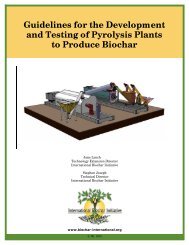Guidelines on Practical Aspects of Biochar Application to Field Soil ...
Guidelines on Practical Aspects of Biochar Application to Field Soil ...
Guidelines on Practical Aspects of Biochar Application to Field Soil ...
- No tags were found...
You also want an ePaper? Increase the reach of your titles
YUMPU automatically turns print PDFs into web optimized ePapers that Google loves.
1. PurposeThis guide provides an overview <strong>of</strong> current biochar knowledge pertinent <strong>to</strong> its applicati<strong>on</strong> <strong>to</strong>soil, and gives ideas for using biochar in a variety <strong>of</strong> soil management systems. Very littledata is currently available <strong>on</strong> practical aspects <strong>of</strong> working with biochar, including laborrequirements, ec<strong>on</strong>omic feasibility and efficacy. This guide summarizes what is known s<strong>of</strong>ar and is intended as a practical guide for farmers and others engaged in biochar fieldtrials.2. Introducti<strong>on</strong>When it is added <strong>to</strong> soil, biochar has generally been shown <strong>to</strong> be beneficial for growingcrops; additi<strong>on</strong>ally biochar c<strong>on</strong>tains stable carb<strong>on</strong> (C) and after adding biochar <strong>to</strong> soil, thiscarb<strong>on</strong> remains sequestered for much l<strong>on</strong>ger periods than it would in the original biomassthat biochar was made from. Crop yield improvements with biochar have beendem<strong>on</strong>strated repeatedly for acidic and highly weathered tropical field soils (Lehmann etal., 2003; R<strong>on</strong>d<strong>on</strong> et al., 2007; Steiner et al., 2007; Kimetu et al., 2008), and there is newdata <strong>on</strong> biochar use in temperate soils <strong>of</strong> higher fertility (Laird, 2009; Husk and Major,2010). While many reports <strong>on</strong> biochar trials exist in the scientific literature, the practice <strong>of</strong>applying it <strong>to</strong> soil in commercial farm or other “real life” operati<strong>on</strong>s is just beginning, andno widely accepted guidelines currently exist.Although biochar is not <strong>of</strong>ficially recognized by any regula<strong>to</strong>ry regime or program as amethod for generating C <strong>of</strong>fsets, it holds promise because its mean residence time in soil isestimated <strong>to</strong> be in the scale <strong>of</strong> centuries <strong>to</strong> millennia (Cheng et al., 2008; Kuzyakov et al.,2009; Major et al., 2010a). In order <strong>to</strong> ensure that biochar management remains a carb<strong>on</strong>negative practice, special attenti<strong>on</strong> must be placed <strong>on</strong> minimizing the full lifecycle costs <strong>of</strong>handling and applying biochar at scale.3. General c<strong>on</strong>siderati<strong>on</strong>s for biochar applicati<strong>on</strong> <strong>to</strong>soil3.1 Characterizati<strong>on</strong> and testing <strong>of</strong> biochar materialsDetermining where and how <strong>to</strong> apply biochar begins with the characterizati<strong>on</strong> <strong>of</strong> thebiochar material. Characteristics <strong>of</strong> biochar materials will vary depending <strong>on</strong> what thebiochar is made from, and how it is made. Variati<strong>on</strong> in the pH, ash c<strong>on</strong>tent, surface area,and other characteristics <strong>of</strong> biochar is the basis for the c<strong>on</strong>cept <strong>of</strong> “designerbiochar” (Novak et al., 2009b), where the characteristics <strong>of</strong> a biochar are matched <strong>to</strong> thespecific needs <strong>of</strong> a soil and/or soil management system. For example, certain high-pHbiochars may be best for applying <strong>to</strong> acidic soils, while others with elevated c<strong>on</strong>tents <strong>of</strong>highly recalcitrant C (but which are amorphous in structure) might be better suited <strong>to</strong>situati<strong>on</strong>s where C sequestrati<strong>on</strong> is the main goal. To date, actual field data is lacking <strong>to</strong><str<strong>on</strong>g>Guidelines</str<strong>on</strong>g> for <strong>Biochar</strong> Applicati<strong>on</strong> <strong>to</strong> <strong>Soil</strong>—Internati<strong>on</strong>al <strong>Biochar</strong> Initiative Page 5



